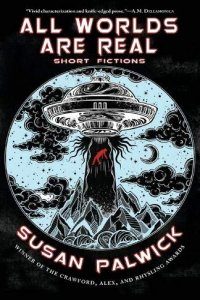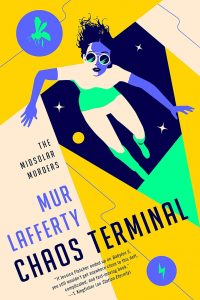Gary K. Wolfe Reviews All Worlds Are Real by Susan Palwick
 All Worlds Are Real, Susan Palwick (Fairwood Press 978-1-933846-84-2, $17.99, 320pp, tp) November 2019.
All Worlds Are Real, Susan Palwick (Fairwood Press 978-1-933846-84-2, $17.99, 320pp, tp) November 2019.
In her introduction to All Worlds are Real, Jo Walton correctly notes that Susan Palwick is “definitely not as well known as a writer this good ought to be at this point in her career.” While one reason for this is that she’s not been especially prolific – four novels and one prior collection in a career dating back to 1985 – I suspect another is that Palwick’s deeply moral fictions don’t really emerge from the traditions of SF and fantasy so much as they kidnap those traditions for their own purposes. Palwick describes herself “a proud member of the Christian Left,” and while there are themes of faith and spirituality in her fiction, that’s in no way indicative of a Sunday school imagination: few other writers I can think of would begin one story in the gift shop of Dante’s hell (“Lucite”), or set another in a BDSM dungeon after the Rapture (“Sanctuary”), or feature Matisse-loving singing space cucumbers haunting a Nevada drug dealer’s home (“Cucumber Gravy”).
When Palwick draws on the resources of SF, which she does in about a half-dozen of the 15 stories here, they tend to play a supporting role in a tale focused elsewhere. For example, the collection is bookended by two stories featuring generation starships. The lead story, “Windows”, centers on a stressed-out mother taking a long bus ride to visit her son in prison for drug dealing, while her daughter has long since departed on a generation ship, after winning a lottery to be included. The parallels between the two kinds of long-term confinement, one a punishment and the other a reward, are elegantly drawn, but the real center of the story is the mother Vangie, coping with the different ways of losing her children. The concluding story, “Wishbone” (one of three original to the collection), consists of the response of a last Earth-born passenger to interview questions, making clear her anxiety about what memories will survive and her concern that a growing faction of “Unearthers” are creating a mythology that the Earth never even existed. Again, the focus is not on the voyage so much as on the importance of remembering (it reminded me a bit of Sarah Pinsker’s “Wind Will Rove” in her recent collection).
Similarly, the idea of alien visitors mostly functions as a kind of distorting mirror to reveal the anxieties and alienation of human characters. “Recoveries”, according to Palwick’s note, arose from the realization that AA could stand for both Alcoholics Anonymous and Alien Abductees, so the plot traces the life of a young woman with a chronic alcohol problem whose parents believe they were abductees. The second-person narration follows the point of her best friend, with her own problems – raised in a series of foster homes, with an almost panicky aversion to doctors – resulting in a clever point-of-view twist that some readers may object to as a little Roger Ackroyd-like. Those singing space cucumbers in “Cucumber Gravy”, which also have the habit of disintegrating into brown goo from time to time, reveal less about their possible origins than about the reclusive marijuana-grower whose home they invade and the visiting preacher who tries to incorporate them into his faith. As the space cucumbers might suggest, Palwick often shows a wicked sense of humor, which is most effectively on display in “Sanctuary”, about a community which forms around a former BDSM dungeon following the Rapture; they’re also plagued by random objects changing form without warning and by ratty little Raphael-style angels “like fat giant babies with stubby chicken wings,” who can barely fly and aren’t even housetrained. When an oncoming mob threatens their redoubt, though, the survivors discover their true values.
The best and most powerful SF story here is “Hhasalin”, set on a colony planet where humans have subdued the native population, some of whom are “shapers” who can conjure objects – and sometimes whole buildings – out of thin air. The young Lhosi, adopted from an orphanage by a human family, can only manage small objects, and is too small and uncoordinated to participate in the human sports her adoptive family enjoys, but is told that someday she can visit a wonderful city built by her own people, where she will find a mate. Except for a bratty younger brother, the family treats her with kindness and patience, until we learn the devastating reasons behind their apparent charity. A similar outsider dynamic is at work in “City of Enemies”, in which a teenage girl suicide bomber is saved by a robot when her bomb fails to detonate, and grows up in the enemy city, where her only consistent friend is the robot who rescued her. The remaining SF story, “Weather”, concerns a father trapped by a snowstorm en route to visit his estranged, dying daughter; the strained relationship is far more central than the SF element of the daughter’s consciousness being “translated” online.
Palwick’s other tales draw on such traditions as the ghost story (“Remote Presence”, with a lonely ghost haunting a remote-presence video unit in a medical center, while the chaplain is supposed to serve double duty as an exorcist), mythology (“Homecoming”, an updated if somewhat predictable take on the sirens, involving a girl disguised as a boy to go to sea with her real boyfriend), and folklore (“Ash”, which reads like a sharper-edged take on Silverstein’s The Giving Tree, suggesting the horror story that lurks within that soft-headed fable). There’s even a magical tape measure in “Hideous Flowerpots”, which begins as an exploration of women’s self-loathing but ends on a syrupy New Age note. Palwick sometimes succumbs to sentiment, as here and with the repulsive dog who helps a victim of mental illness in “Hodge”. Even when her plots get a bit tidy, her sense of her characters’ pain is acute, and despite the lovable ugly dog, the insight into the young woman’s mental anguish in “Hodge” is sharp and insightful. In the end, we come away remembering the characters more than the tropes, and what’s wrong with that?
Gary K. Wolfe is Emeritus Professor of Humanities at Roosevelt University and a reviewer for Locus magazine since 1991. His reviews have been collected in Soundings (BSFA Award 2006; Hugo nominee), Bearings (Hugo nominee 2011), and Sightings (2011), and his Evaporating Genres: Essays on Fantastic Literature (Wesleyan) received the Locus Award in 2012. Earlier books include The Known and the Unknown: The Iconography of Science Fiction (Eaton Award, 1981), Harlan Ellison: The Edge of Forever (with Ellen Weil, 2002), and David Lindsay (1982). For the Library of America, he edited American Science Fiction: Nine Classic Novels of the 1950s in 2012, with a similar set for the 1960s forthcoming. He has received the Pilgrim Award from the Science Fiction Research Association, the Distinguished Scholarship Award from the International Association for the Fantastic in the Arts, and a Special World Fantasy Award for criticism. His 24-lecture series How Great Science Fiction Works appeared from The Great Courses in 2016. He has received six Hugo nominations, two for his reviews collections and four for The Coode Street Podcast, which he has co-hosted with Jonathan Strahan for more than 300 episodes. He lives in Chicago.
This review and more like it in the December 2019 issue of Locus.
 While you are here, please take a moment to support Locus with a one-time or recurring donation. We rely on reader donations to keep the magazine and site going, and would like to keep the site paywall free, but WE NEED YOUR FINANCIAL SUPPORT to continue quality coverage of the science fiction and fantasy field.
While you are here, please take a moment to support Locus with a one-time or recurring donation. We rely on reader donations to keep the magazine and site going, and would like to keep the site paywall free, but WE NEED YOUR FINANCIAL SUPPORT to continue quality coverage of the science fiction and fantasy field.








